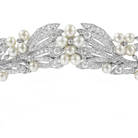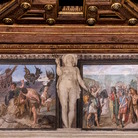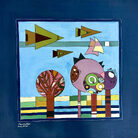Recycling Beauty

Dal 17 November 2022 al 27 February 2023
Milano
Luogo: Fondazione Prada
Indirizzo: Largo Isarco 2
Orari: 10-19. Chiuso martedì
Curatori: Salvatore Settis con Anna Anguissola e Denise La Monica
Costo del biglietto: intero € 15, ridotto € 12 / € 7.50. Gratuito Under 18 Visitatori con disabilità Giornalisti accreditati o in possesso di tessera stampa in corso di validità Visitatori sopra i 65 anni residenti nel comune di Milano, in possesso di un documento di identità (solo il giovedì)
Telefono per informazioni: +39 02 5666 2611
E-Mail info: info@fondazioneprada.org
Sito ufficiale: http://fondazioneprada.org
La mostra si inserisce in un’indagine più estesa che Fondazione Prada ha intrapreso dal 2015 quando presentò contemporaneamente negli spazi di Milano e Venezia “Serial Classic” e “Portable Classic”, due esposizioni curate da Salvatore Settis (con Anna Anguissola a Milano e con Davide Gasparotto a Venezia) e progettate da Rem Koolhaas/OMA. La premessa di questa ricerca è la necessità di considerare il classico non solo come un’eredità del passato, ma come un elemento vitale in grado di incidere sul nostro presente e futuro. Temi come la serialità, il riuso e il riciclo nell’arte sono strettamente legati alla nostra concezione di modernità, ma testimoniano anche la straordinaria persistenza di alcuni valori, categorie e modelli classici. Attraverso un innovativo approccio interpretativo e modalità espositive sperimentali, il patrimonio antico, e in particolare quello greco-romano, diventa, per usare le parole di Settis, “una chiave di accesso alla molteplicità delle culture del mondo contemporaneo”.
Nonostante la sua rilevanza culturale e la sua ampia diffusione, il reimpiego di materiali antichi è stato al centro degli studi archeologici solo di recente. Solo negli ultimi anni è stato approfondito il dato essenziale di questo fenomeno, ovvero la relazione visuale e concettuale fra gli elementi antichi riusati e il contesto post-antico, lontano da quello di origine, in cui sono stati inclusi. “Recycling Beauty”, al contrario, intende focalizzare l’attenzione sul momento in cui il pezzo antico abbandona la propria condizione iniziale o di rovina e viene riattivato, acquistando nuovo senso e valore grazie al gesto del riuso. Ogni elemento di reimpiego non solo modifica il contesto in cui è inserito, ma ne viene a sua volta modificato in un meccanismo di reciproca legittimazione e attribuzione di senso. Esplorare la natura fluida e molteplice degli oggetti d’arte che nel tempo cambiano per utilizzo, ricezione e interpretazione equivale a riflettere sulla natura instabile e trasformativa dei processi artistici.
Il progetto espositivo, concepito da Rem Koolhaas/OMA con Giulio Margheri, si sviluppa in due edifici della Fondazione, il Podium e la Cisterna, come un percorso di analisi storica, scoperta e immaginazione. Alcune parti del progetto provengono da materiali di precedenti mostre ospitate alla Fondazione Prada e aggiungono una dimensione spaziale al tema chiave di “Recycling Beauty”. L’allestimento del Podium invita i visitatori a confrontarsi con gli oggetti esposti con diverse intensità. Un paesaggio di plinti bassi in acrilico permette di percepire i pezzi esposti come un insieme, mentre le strutture simili a postazioni di lavoro incoraggiano un esame più ravvicinato grazie alla presenza di sedie da ufficio. Nella Cisterna i visitatori incontrano gli oggetti gradualmente, in una sequenza di spazi che facilitano l’osservazione da punti di vista alternativi: dall’altezza di un balcone, alla prospettiva ristretta di una stanza costruita all’interno di uno degli ambienti esistenti. Due sale della Cisterna saranno dedicate alla statua colossale di Costantino (IV sec. d.C.), una delle opere più importanti della scultura romana tardo-antica. Due monumentali frammenti marmorei, la mano e il piede sinistro, normalmente esposti nel cortile del Palazzo dei Conservatori a Roma, saranno accostati a una ricostruzione del Colosso in scala 1:1, mai tentata prima. Questo progetto è il risultato di una collaborazione tra i Musei Capitolini, Fondazione Prada e Factum Foundation, la cui supervisione scientifica è stata seguita da Claudio Parisi Presicce, Sovrintendente Capitolino ai Beni Culturali.
Il percorso espositivo ospita oltre cinquanta opere d’arte altamente rappresentative provenienti da collezioni pubbliche e musei italiani e internazionali come Musée du Louvre di Parigi, Kunsthistorisches Museum di Vienna, Ny Carlsberg Glyptotek di Copenhagen, Musei Capitolini, Musei Vaticani e Galleria Borghese di Roma, Gallerie degli Uffizi di Firenze e Museo Archeologico Nazionale di Napoli. “Recycling Beauty” intende marcare il grande valore artistico e storico delle opere presentate, ma anche dimostrare come queste siano il prodotto di migrazioni, trasformazioni ed evoluzioni di senso. Evidenziando l’importanza dei frammenti, del riuso e dell’interpretazione, la mostra contribuisce a considerare il passato come un fenomeno instabile in costante evoluzione.
SCARICA IL COMUNICATO IN PDF

-
 Dal 14 November 2025 al 15 March 2026
Roma | Musei Capitolini
Dal 14 November 2025 al 15 March 2026
Roma | Musei Capitolini
Cartier e il Mito ai Musei Capitolini
-
 Dal 14 November 2025 al 15 February 2026
Bologna | Palazzo Fava
Dal 14 November 2025 al 15 February 2026
Bologna | Palazzo Fava
Michelangelo e Bologna
-
 Dal 13 November 2025 al 18 April 2026
Roma | Musei Vaticani
Dal 13 November 2025 al 18 April 2026
Roma | Musei Vaticani
“L’irrefrenabile curiosità”. Capolavori del Novecento dalla Collezione di Leone Piccioni
-
 Dal 15 November 2025 al 10 May 2026
Treviso | Museo Santa Caterina
Dal 15 November 2025 al 10 May 2026
Treviso | Museo Santa Caterina
DA PICASSO A VAN GOGH. Capolavori dal Toledo Museum of Art. Storie di pittura dall’astrazione all’impressionismo
-
 Dal 8 November 2025 al 11 January 2026
Venezia | Museo Correr
Dal 8 November 2025 al 11 January 2026
Venezia | Museo Correr
CARATTERI. Calligrafia e tipografia: Corea del Sud e Stati Uniti
-
 Dal 8 November 2025 al 22 February 2026
Brescia | Museo di Santa Giulia
Dal 8 November 2025 al 22 February 2026
Brescia | Museo di Santa Giulia
Material for an Exhibition. Storie, memorie e lotte dalla Palestina e dal Mediterraneo


